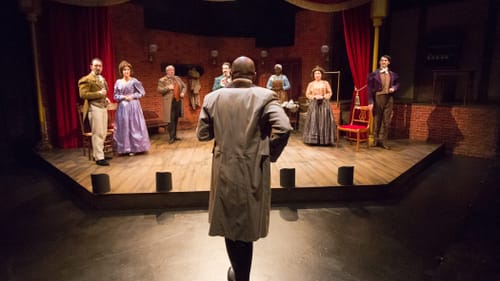Stay in the Loop
BSR publishes on a weekly schedule, with an email newsletter every Wednesday and Thursday morning. There’s no paywall, and subscribing is always free.
Historical play, right for today
Lantern Theater Company presents Lolita Chakrabarti's 'Red Velvet'

The best plays about the past reveal something about the present; in them, the present provides perspective on the past. Consider the story of Ira Aldridge (1807–1867), an African-American actor who relocated to England to play classical roles. Aldridge is brought to life in Lantern Theater’s production of Lolita Chakrabarti’s Red Velvet.
This Lantern season opener, directed with appropriate sensitivity by Peter DeLaurier, shows Aldridge (Forrest McClendon) arriving in 1833 London after years of provincial obscurity to replace the great Edmund Kean in Shakespeare’s Othello. Amid England’s contentious slavery debate — after years of demonstrations and petitions, kept offstage in Red Velvet, their Slavery Abolition Act passed in 1833 — a black man playing Othello might offer some evidence of equality. Alas, not so.
Acting styles
Charkrabarti's debut play (she is also a stage actor) portrays Aldridge as an artist ahead of his time. McClendon embodies him with dignity, skill, and passion. The Covent Garden cast — including Adam Hammet as Edmund Kean’s son Charles, David Bardeen as career character actor Bernard, David Pica as eager pupil Henry, and Liz Filios as inexperienced Betty — are an often-amusing cross-section of British acting at the time, exemplified by Charles’s lurid Iago poses. Aldridge bonds with Ellen Tree, his Desdemona, who's excited by his desire to play emotions realistically and with conviction.
“I would rather slide in and out of the rules,” says Aldridge, perhaps speaking about more than acting, “than be strangled by them."
The actors trust that producer Pierre (Damon Bonetti) is saving Othello with a capable replacement, but none know that the replacement is black until he arrives, shocking them. Bernard diplomatically notes that “the English are open . . . to a point." He also asks, "How do you think this theater was built?" Charles claims a black Othello "will prevent them” — the audience — “from escaping reality." Ellen remarks ruefully, “They said the same thing about women.”

Great reckonings in a small room
DeLaurier’s production suggests Covent Garden’s vast size in the Lantern's small space. Meghan Jones’s scenic design frames the main playing area with footlights, a proscenium arch, and a red velvet curtain, lit with convincing facsimiles of period gas lighting by Lily Fossner. Christopher Colucci’s sound design includes the empty theater’s echo, and Janus Stefanowicz’s costumes replicate the era’s excesses and the actors’ limited means.
Covent Garden's size matters not only because it represents success, but because Aldridge crafts his performance so everyone in the huge house can appreciate it. However, when Pierre asks him to "tone it down," it's because people can't accept a black man demonstrably in love with a white woman and actually touching her. Of course, that's exactly what the play requires.
Chakrabarti resists portraying Aldridge and Ellen as lovers; their flirtation is artistic, not romantic, as they invent modern acting. “To act spontaneously,” Ellen realizes, “one must know exactly what’s coming.” They have great fun figuring out how Aldridge can realistically strangle Desdemona without hurting Ellen. Their joyous collaboration is compromised, however, when the cast reads the reviews the morning after his first performance.
They’re horrifying by modern standards, viciously racist, and Chakrabarti uses direct quotes. Aldridge isn’t present when the actors read the reviews aloud, but black servant Connie (Ebony Pullum) is; she barely speaks, yet we watch her listen. She's a ghostly figure, almost invisible and unnecessary, but Pullum's silent intensity makes her irresistible. When Connie finally opens up to Aldridge, we're rewarded with her unique point of view.
Red Velvet is framed by a scene in Poland 34 years later. Aldridge, performing King Lear, has been touring classics in Europe, never achieving the fame glimpsed during those two nights playing Othello in London. The scenes, featuring Filios as a young reporter, not only provide historical context and complete Aldridge's story, but touch the present through the abuse endured by the paper's only female employee.
If only Red Velvet portrayed a primitive time different from our own. In this land of the free 150 years later, we're still awaiting equality for women and people of color.
What, When, Where
Red Velvet. By Lolita Chakrabarti, Peter DeLaurier directed. Through October 15, 2017, at the Lantern Theater Company, St. Stephen's Theater, 10th and Ludlow Streets, Philadelphia. (215) 829-0395 or lanterntheater.org.
Sign up for our newsletter
All of the week's new articles, all in one place. Sign up for the free weekly BSR newsletters, and don't miss a conversation.

 Mark Cofta
Mark Cofta